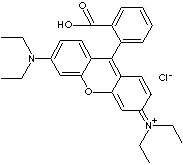| CAS
NO. |
81-88-9
|
 S S
|
| EINECS
NO. |
201-383-9 |
| FORMULA |
C28H31ClN2O3 |
| MOL
WT. |
479.02 |
| H.S.
CODE |
3204.13.8000 |
| TOXICITY |
|
| UN
NO. |
|
| SYNONYMS |
C.I.
Basic Violet 10; C.I. 45170; |
| Tetraethylrhodamine,hydrochloride; 9-(2-carboxyphenyl)-3,6-bis(diethylamino)
xanthylium chloride; N-[9-(2-carboxyphenyl)-6-(diethylamino)-
3H-xanthen-3- ylidene]- N-ethyl- Ethanaminium chloride;
[9-(o-carboxyphenyl)-6-(diethylamino)- 3H-xanthen-3-
ylidene]diethyl-Ammonium
chloride; C.I. Food Red 15; (9-(o-Carboxyphenyl)-6-(diethyl
amino)-3H-
xanthen-3-ylidene) diethylammonium chloride; |
|
SMILES |
c1(c2c(oc3c1ccc(\c3)=[N+](/CC)CC)cc(N(CC)CC)cc2)c1c(cccc1)
C(O)=O.[ClH-] |
|
CLASSIFICATION
|
Dye, Stain
|
|
EXTRA
NOTES
|
Overall Carcinogenic Evaluation: Group 3 |
|
PHYSICAL
AND CHEMICAL PROPERTIES
|
| PHYSICAL
STATE |
red
to violet powder |
| MELTING
POINT |
210
- 211 C (Decomposes) |
| BOILING
POINT |
|
| SPECIFIC
GRAVITY |
>
1.0 |
| SOLUBILITY
IN WATER |
Soluble |
| SOLVENT
SOLUBILITY |
Slightly soluble in HCl and NaOH soluble in alcohol |
| log Pow |
1.95
(Octanol-water) |
| VAPOR
PRESSURE |
1.89E-19 (mmHg at 25 C) |
| OH RATE
CONSTANT |
2.37E-10
(cm3/molecule-sec
at 25 C Atmospheric ) |
| AUTOIGNITION
|
|
| pH |
|
| VAPOR
DENSITY |
|
| NFPA
RATINGS |
Health:
1 Flammability: 0 Reactivity: 0 |
| FLASH
POINT |
|
| STABILITY |
Stable
under ordinary conditions |
|
EXTERNAL LINKS
& GENERAL
DESCRIPTION
|
|
Wikipedia
Linking
Material
Safety Data Sheet
Google
Scholar Search
http://stainsfile.info/
Rhodamine B is an amphoteric dye, although usually listed as basic as it has an
overall positive charge. It is most commonly used as a fluorochrome, an example
being in mixture with auramine O to demonstrate acid fast organisms.
Local: Basic dyes are
salts of the colored organic bases containing amino and imino groups and also
combined with a colorless acid, such as hydrochloric or sulfuric. They are
brilliant and most fluorescent among all synthetic dyes but have poor light and
wash fastness. Cotton dyes having higher fastness properties replace in dyeing
cotton for them. Basic dyes are cationic which has positive electrical charge
and are used for anionic fabrics which are negative-charge-bearing, such as
wool, silk, nylon, and acrylics where bright dying is the prime
consideration.
BIOLOGICAL STAINS, INDICATORS
|
| SALES
SPECIFICATION |
|
APPEARANCE
|
red
to violet powder |
| CONTENT |
95.0%
min
|
| TRANSPORTATION |
| PACKING |
25kgs
in fiber drum |
| HAZARD
CLASS |
Not
regulated |
| UN
NO. |
|
| SAFETY
INFORMATION |
| Hazard Symbols: XN, Risk Phrases: 22/40, Safety
Phrases: 36/37/45 |
| PRICE INFORMATION |
|
 S
S